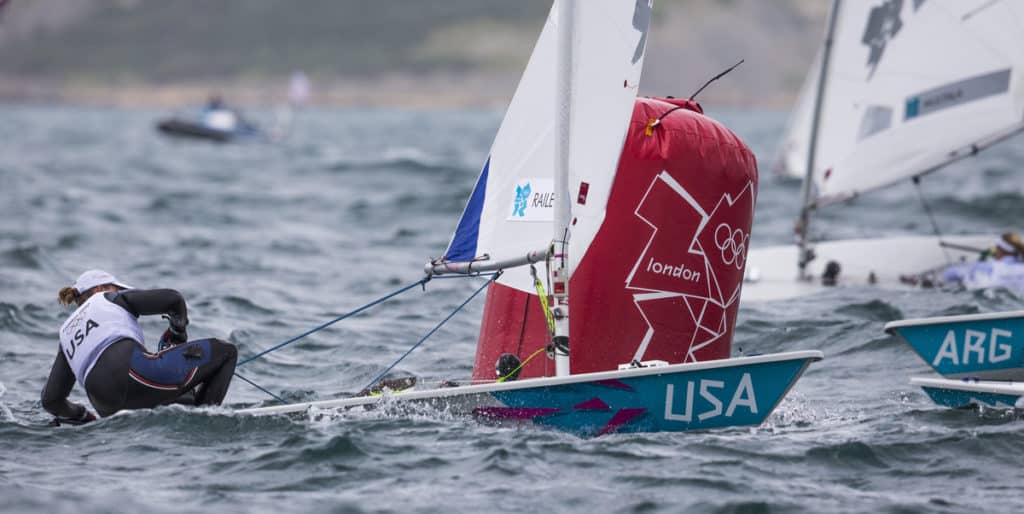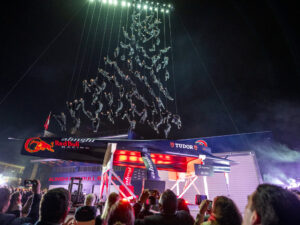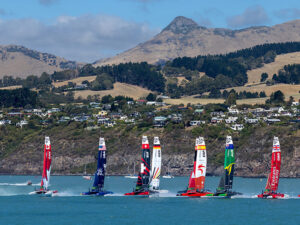
**Below is part II of a post-regatta review of the U.S. Sailing Team Sperry Top-Sider’s performance at the 2012 Olympics. For Part I, please click here. **
What about the Trials, should we go back to the old system?
The move to an international Trials, which utilized a series of international regattas to select the 2012 U.S. Olympic Sailing Team, was the only logical choice for US Sailing’s Olympic Sailing Committee. It’s expensive, and it hurts all the classes domestically, but ISAF World Cup regattas and the ISAF Combined World Championships (always held the year before the Olympics) are far better venues for selecting the best medal hopeful than a small domestic regatta with a few good teams and a handful, or even a lot, of teams that could never compete on the world level. One change to consider: Set up the Trials much as before, using two or more World Cup level regattas the year before the Olympics, but add in a clause that if the winner doesn’t achieve a certain standard (making the medal race in at least one of the selected regattas, for example), then the selection can be delayed until the spring events of the Olympic year. The logic against doing this is it spreads out money that should ideally be focused on getting one athlete or team ready for the Games, it forces athletes to think short term, and it doesn’t encourage the experimentation that can lead to a medal-winning edge, which is vital to equipment-intensive classes like the 470, Finn, or Star. However, a Trials winner who can’t make the medal race in the world championships, or another ISAF World Cup regatta, in the year prior to the Olympics isn’t on the medal track to begin with.
Anything else we should change? Are we developing athletes properly?
The team has undergone tremendous change over the last four years. Two of the prime goals during the Brenner/Andreasen regime were to raise more money and to get more fit. I don’t think anyone will argue the value of those. They’ve also committed a lot of money and effort to the development program, which was launched in 2009.
The 1992 U.S. Sailing Team won medals in nine of 10 classes at the Barcelona Olympics. While the team tumbled to just two bronze in Atlanta in 1996, the momentum from that Barcelona team carried forward a lot longer than most people realize.
The four medals we won in 2000 were all won, in part at least, by alumni from that team: Mark Reynolds in the Star, JJ Fetter (Isler) in the Women’s 470, Paul Foerster in the Men’s 470, and Jonathan McKee in the 49er. Reynolds, Fetter, and Foerster all won medals in 1992. McKee was the team’s head coach, along with being a gold medalist from 1984, while his brother Charlie, who crewed from him in 2000, was a bronze medalist from 1988.
In 2004, the Forester teamed up with another medalist from 1992, Kevin Burnham, and took gold. The second medal was a silver for John Lovell and Charlie Ogletree, who were then sailing in their third Olympics.
On the surface 2008, with 20-somethings Anna Tunnicliffe and Zach Railey winning medals, seems like the birth of a new generation of sailors. But one was (and is) a supremely motivated female athlete who benefitted from training against Paige Railey, one the more experienced Radial sailors in the world at that time; the other was developed largely outside the U.S. Sailing Team pipeline.
The lack of a strong development pipeline in the 90s and 2000s is one of the prime reasons the team under performed in London. The older generation—imbued with the DIY ethic that powered the U.S. Sailing Team to such great success for so many years—aged out of the Olympics and we simply were not filling the ranks with enough younger talent.
This pipeline is still a work in progress, but it’s a huge step in the right direction. Unfortunately, the results won’t be seen until Rio, or possible 2020, wherever those summer games are held (the U.S. decided not to bid, Tokyo, Madrid and Istanbul are the three options for the IOC.)
One potential issue with the pipeline now is it requires sailors to get into certain classes, and up to a certain standard, on their own. This puts the bar of entry above what many families can afford. It would be great to see a grant program for talented high school and/or college sailors who don’t have the family resources to qualify. Getting sailors exposed to international competition at an early age is key.
Are you saying we need to get sailors to skip college sailing and get on the international track earlier?
Yes and no. College sailing is a popular scapegoat when the discussion turns to why the United States can’t compete on the international circuit. A sailor who does nothing but high school and college sailing, and then heads out on the Olympic-class circuit is well behind his foreign peers, and is likely to be quickly discouraged (not to mention the issue of college debt that may hang over his or her head). But with ISAF continuing to focus on shorter courses on shiftier, closer-to-shore venues, college sailing skills may translate more and more on the international level. The key is to get sailors exposed to international sailing early on, so instead of taking a summer job teaching sailing, they get on the development team and head to Europe for a month or more. So instead of spending winter break hanging out at home or going skiing, they head to Florida and train for and then race in the Rolex Miami OCR. So instead of sailing on the Vanguard 15 circuit (which is great, no offense intended) they race a 470, 49er, 29er, or Nacra 17 in their free time.
One of the rising stars of the Laser class, Juan Maegli Aguero of Guatemala, is a product of the U.S. high school and college sailing system (Portsmouth Abbey, in Rhode Island, and the College of Charleston, in South Carolina). He appreciates what college sailing taught him, but he also knew what he needed to do to compete on the Olympic level. When he was in school, and sailing on the collegiate circuit, he worked on his fitness, then two years before the Games, he left school to train full time. He was ninth at the 2012 Olympics—and fourth at the Laser worlds in June. He’ll be back at Charleston this fall and, after a bit of a break from sailing, is eager to do some team racing next spring. He’s also planning to compete in Rio in 2016.
Speaking of 2016, is there any reason to be optimistic for the U.S. team chances?
Many. Paige Railey said outright she’s in for 2016; probably in the Radial, thought the coed multihull is an option. Charlie Buckingham was, according to the results, the best American Laser sailor this spring. He made the medal race in three European regattas and was at the Olympics as the coach for Cy Thompson of the U.S. Virgin Islands. Brenner said both Zach Railey and Anna Tunnicliffe are also eyeing 2016. Tunnicliffe is reportedly looking at the women’s skiff. I wouldn’t bet against her since that boat could be perfectly suited for her talents. Railey, if he comes back, will have to beat Caleb Paine, now ranked 16th in the world, for the Finn berth. Sarah Lihan enjoyed her first Olympics and wouldn’t rule out a return, though skipper Amanda Clark is finished. Erik Storck and Trevor Moore were also going to digest the experience before making any decisions. Hopefully the team can convince them to return, either together or with other partners. And the U.S. is a dominant force on the kiteboard racing circuit, though that circuit is in for a shock as all the displaced Olympic windsurfers look for a new class to apply their talents and discipline.
Finally, there’s the title sponsorship of Sperry Top-Sider. They’re committed, in every sense of the word, to helping this team come back from Rio with a big haul. Starting the quad with that kind of support is a huge plus.
Any final thoughts?
One common thread that linked a few of the Aussie gold medalists (Nathan Outteridge in the 49er, Tom Slingsby in the Laser, and Malcolm Page in the 470) is they did a lot of professional sailing in other boats. The U.S. team, by and large, focused exclusively on their boat. Cross training in Farr 40s, Melges 32s, IRC 52s, or even handicapped big boats, can be both lucrative and instructive. Maybe the plan for 2016 should include an emphasis on getting the U.S. Sailing Team athletes, especially the experienced ones whose learning curves in their chosen classes have flattened out, sailing in a variety of boats.
The U.S. Sailing Team is planning a thorough review of the 2012 Games and the last four years. It’s something, Brenner said, they would do regardless of the finish. However, coming back from Weymouth with no hardware should sharpen the focus significantly.
In 2010, I spent some time embedded with the U.S. team at the U.S. Olympic Training Center in Colorado Springs, and at Kiel Week in Germany. I saw a team moving in the right direction, a team, as Amanda Clark said in her tearful final interview, that is “not a group of individual campaigns any longer, it’s a team campaign.” On a personal level, it was very disappointing to see these athletes struggle. They are a very likeable and dedicated bunch of sailors. With the possible exception of the America’s Cup, no inshore sailing requires more of a sailor than Olympic-class sailing. And the Cup comes with much greater financial rewards.
It’s tempting to want to start fresh after a disaster. But whether looking at the coaches, the team’s policies, or the athletes, it’s important not to throw out the good just to get rid of the bad. Olympic sailing is a building process; it can take multiple Olympic campaigns to mold a champion. The same can be said of a champion team. There will always be bumps along the way; hopefully, in four years, the U.S. team can look back on Weymouth and realized they learned more from this regatta than they would’ve learned from a wildly successful one.









